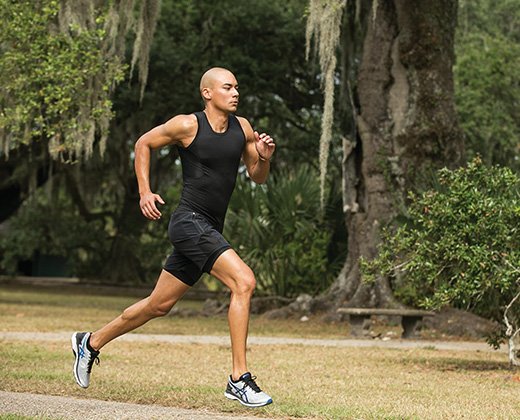Running is addictive. Running is best enjoyed when the runner feels best. Choosing the perfect men’s running shoe might seem difficult with many options available. Here are some easy-to-follow pointers to check while picking that men’s running shoe that will lead you through a great adventure.
1. Know Yourself Thoroughly
Know yourself. Know your weight, your frequency of running, your target distances, or the type of terrain you would be running. While running, two-thirds of the bodyweight is applied to the feet, joints, and muscles. Without proper cushioning, the shock would directly absorb the feet and joints. All these play a significant role in the type of running shoe you choose.
2. How Hard Are You Hitting The Road?
Do you have the competitive juices to try out that marathon you have always wanted, or is running your way to a fitness goal? The intensity of your running would depend on the type of shoe you choose.
- If you have long runs for three or more days of the week, get shoes that offer good cushioning for comfort and stability to the feet. These shoes give your feet the needed support to endure these sessions.
- For killing it out there in the local marathon in your city, go for a more lightweight shoe with an aerodynamic structure for that added push.
- For athletes looking to better their records, an ultra-light shoe would be your best bet, as these shoes are made purely for speed and performance when they matter the most.
Shop PUMA men’s running shoes online and find the perfect shoe for your event!
3. Know The Surface You Tread On
The men’s running shoe chosen can heavily depend on the type of surface the shoe treads on. The cushioning on the shoe depends on the structure of the surface. The types of surfaces to consider while choosing the sport would be:
- For the tarmac, choose running shoes that have good cushioning capabilities and are flexible to adapt to the irregularities the road may offer.
- For trail running, choose a shoe that has a rugged sole that helps protect the feet from irregularity on the surface, like sharp rocks, which are a common element in trail running.
- For indoor treadmill sessions, use shoes that have a soft sole with ample ventilation.
4. Types Of Running Shoes
The running shoe chosen would depend on the type of foot structure and the pronation of the feet. The three main categories of men’s running shoes are
- Stability Shoes: They are mainly used when the runner has mild arch problems. They provide stability and added comfort for the feet.
- Motion Control Shoes: These shoes help to correct pronation during a run. They have rigid plastic or fiberglass lining, supporting the feet that move inward during the run.
- Cushioning shoes: People with outward pronation use these shoes to support feet with high arches. They are lightweight and are more rigid than regular running shoes.
5. The Fit Must Not Be Compromised
This is easily the most important tip that must be considered while selecting the shoe, as neglecting it can not only cause an uncomfortable experience but can also lead to a potential injury in the future.
- Try the shoe towards the end of the day, as the foot tends to swell up after a run
- There must be a gap of at least ½ to 1 inch between the toe and the front of the shoe.
- The shoe must feel centred on the sole. It must not slide or move uncomfortably while putting them on.
6. Where Do You Need Support
The way your foot hits the ground and reacts is called pronation. Choosing a men’s running shoe that supports the type of pronation you have helps avoid injuries in the long term. The types of pronation seen in runners are
- Basic Pronation: This is the foot’s natural way of rolling inwards during the stride and is a trait of a bio-mechanically optimised runner. The neutral pronation absorbs the impact and does not affect the joints.
- Overpronation: When the foot rolls inwards, there is a greater chance of injury. People with overpronation must choose shoes with better stability to protect the feet.
- Supination: When the foot rolls outwards while running, the shoe chosen must include more flexibility and cushioning. Supination is rare among runners, but without choosing the right type of shoe, it may lead to a permanent injury to the feet.
7. Have You Tried Insoles Yet
Insoles help provide additional support to your heel, arch, and feet ball. They help reduce common runner problems like shin splints, blisters, and slipping. Insoles are designed to complement the shape of the feet, and they will help provide additional support to the sole when it is most needed.
8. Which Socks Are You On
The thickness of the sock chosen heavily affects the shoe’s feel on the runner’s foot. Always go for running socks that provide support along the foot’s arch and have extra padding on the ball of the feet. Try to avoid socks made of 100% cotton, as it tends to hold moisture which would cause blisters and chafing.
Try out that men’s running shoe you’ve always wanted at the nearest PUMA store, and keep these pointers in mind. Happy running!







